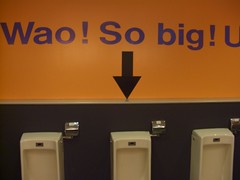- "The best way to spend your money is to spend it on time, not on stuff." http://su.pr/2tr5iP #
- First bonus by stock options today. Not sure I'm impressed. #
- RT @chrisguillebeau: US border control just walked the train asking "Are you a US citizen?" Native American guy says: "One of the originals" #
- @FARNOOSH My credit score is A measure of my integrity not THE measure. in reply to FARNOOSH #
- I'm listening to a grunge/metal cover of "You are my sunshine" #
- There's something funny about a guy on reality TV whining about how private he is. #LAInk #
Twitter Weekly Updates for 2010-04-17
- RT @kristinbrianne: Get Talk and Txt Unlimited Cell Svc w/ Free Phone for $10 per month by joining DNA for Free. http://tinyurl.com/yyg5ohn #
- RT: @ChristianPF is giving away an iPod Touch! – RT to enter to win… http://su.pr/2LS3p5 #
- 74 inch armspan and forearms bigger than my biceps. No, I don't button my shirt cuffs. #
- RT @deliverawaydebt Money Hackers Network Carnival #111 – Don't Hassel the Hoff Edition http://bit.ly/9BIAvE #
- @bargainr What would it take to get you to include me in the personal-finance-bloggers list? #
- Working on a Penfed application to transform my worst interest rate into my best. #
- Gave the 1 year old pop rocks for the first time. Big smiles. #
- @Netflix @Wii disc works well and loads fast. Go, go gadget movie! #
Twitter Weekly Updates for 2010-04-24
- Watching Gamers:Dorkness Rising #
- Charisma? Weee! #
- Tweeting a dork movie? I'm a bit of a geek. #
- We just met and the first thing you do, after boinking a stranger in the presence of the king, is to murder a peasant? #
- Every movie needs a PvN interlude. #
- Everything's better with pirates. #
- Waffles? Recognize. #
- The Spatula of Purity shall scramble the eggs of your malfeasance. #
- Checkout clerks licking their fingers to separate bags or count change is gross. #
- Watching Sparkles the Vampire, Part 2: Bella's Moodswing. #twilight #
- @penfed was a waste of money. $20 down the drain to join, wouldn't give a worthwhile limit, so I can't transfer a balance. #
- @JAlanGrey It's pretty lame. The first one was ok. This one didn't improve on the original. in reply to JAlanGrey #
- RT @tferriss: Are you taking snake oil? Beautiful data visualization of scientific evidence for popular supplements: http://ping.fm/pqaDi #
- Don't need more shelves, more storage, more organization. Just need less stuff. #
- @BeatingBroke is hosting the Festival of Frugality #226 http://su.pr/80Osvn #
- RT @tferriss: Cool. RT @cjbruce link directly to a time in a YouTube video by adding #t 2m50s to end of the URL (change the time). #
- RT @tferriss: From learning shorthand to fast mental math – The Mentat Wiki: http://ping.fm/fFbhJ #
- RT @wisebread: How rich are you? Check out this list (It may shock you!!!) http://www.globalrichlist.com/ #
- RT @tferriss: RT @aysegul_c free alternative to RosettS: livemocha.com for classes, forvo.com for pronunc., lang8.com for writing correction #
- Childish isn't an insult. http://su.pr/ABUziY #
- Canceled the Dish tonight. #
The Magic Toilet

- Image by tokyofortwo via Flickr
My toilet is saving me $1200.
For a long time, my toilet ran. It was a nearly steady stream of money slipping down the drain. I knew that replacing the flapper was a quick job, but it was easy to ignore. If I wasn’t in the bathroom, I couldn’t hear it. If I was in the bathroom, I was otherwise occupied.
When I finally got sick of it, I started researching how to fix a running toilet because I had never done it before. I found the HydroRight Dual-Flush Converter. It’s the magical push-button, two-stage flusher. Yes, science fiction has taken over my bathroom. Or at least my toilet.
I bought the dual-flush converter, which replaces the flusher and the flapper. It has two buttons, which each use different amounts of water, depending on what you need it to do. I’m sure there’s a poop joke in there somewhere, but I’m pretending to have too much class to make it.
I also bought the matching fill valve. This lets you set how much water is allowed into the tank much better than just putting a brick in the tank. It’s a much faster fill and has a pressure nozzle that lies on the bottom of the tank. Every time you flush, it cleans the inside of the tank. Before I put it in, it had been at least 5 years since I had opened the tank. It was black. Two weeks later, it was white again. I wouldn’t want to eat off of it, or drink the water, but it was a definite improvement.
Installation would have been easier if the calcium buildup hadn’t welded the flush handle to the tank. That’s what reciprocating saws are for, though. That, and scaring my wife with the idea of replacing the toilet. Once the handle was off, it took 15 minutes to install.
“Wow”, you say? “Where’s the $1200”, you say? We’ve had this setup, which cost $35.42, since June 8th, 2010. It’s now September. That’s summer. We’ve watered both the lawn and the garden and our quarterly water bill has gone down $30, almost paying for the poo-gadget already. $30 X 4 = $120 per year, or $1200 over 10 years.
Yes, it will take a decade, but my toilet is saving me $1200.
How to Prioritize Your Spending
Don’t buy that.
At least take a few moments to decide if it’s really worth buying.
Too often, people go on auto-pilot and buy whatever catches their attention for a few moments. The end-caps at the store? Oh, boy, that’s impossible to resist. Everybody needs a 1000 pack of ShamWow’s, right? Who could live without a extra pair of kevlar boxer shorts?
Before you put the new tchotke in your cart, ask yourself some questions to see if it’s worth getting.
1. Is it a need or a want? Is this something you could live without? Some things are necessary. Soap, shampoo, and food are essentials. You have to buy those. Other things, like movies, most of the clothes people buy, or electronic gadgets are almost always optional. If you don’t need it, it may be a good idea to leave it in the store.
2. Does it serve a purpose? I bought a vase once that I thought was pretty and could hold candy or something, but it’s done nothing but collect dust in the meantime. It’s purpose is nothing more than hiding part of a flat surface. Useless.
3. Will you actually use it? A few years ago, my wife an cleaned out her mother’s house. She’s a hoarder. We found at least 50 shopping bags full of clothes with the tags still attached. I know, you’re thinking that you’d never do that, because you’re not a hoarder, but people do it all the time. Have you ever bought a book that you haven’t gotten around to reading, or a movie that went on the shelf, still wrapped in plastic? Do you own a treadmill that’s only being used to hang clothes, or a home liposuction machine that is not being used to make soap?
3. Is it a fad? Beanie babies, iPads, BetaMax, and bike helmets. All garbage that takes the world by storm for a few years then fades, leaving the distributors rich and the customers embarrassed.
4. Is it something you’re considering just to keep up with the Joneses? If you’re only buying it to compete with your neighbors, don’t buy it. You don’t need a Lexus, a Rolex, or that replacement kidney. Just put it back on the shelf and go home with your money. Chances are, your neighbors are only buying stuff so they can compete with you. It’s a vicious cycle. Break it.
5. Do you really, really want it? Sometimes, no matter how worthless something might be, whether it’s a fad, or a dust-collecting knick-knack, or an outfit you’ll never wear, you just want it more than you want your next breath of air. That’s ok. A bit disturbing, but ok. If you are meeting all of your other needs, it’s fine to indulge yourself on occasion.
How do you prioritize spending if you’re thinking about buying something questionable?
Breaking Bad: The Economics of Meth

In AMC’s “Breaking Bad,” Walter White plays the role of chemistry teacher turned meth producer and drug kingpin. While it certainly makes for good television to think about the profits available to someone willing to trade in illegal drugs, the mountain of money that Walter makes by the end of the series is actually not that unrealistic. Meth has a street value that approaches $30,000 dollars per pound. Not only that, but Walter displays a deceptively keen business acumen, especially for a chemistry teacher. A number of keen decisions allowed Walter White to become as successful as he has.
Production Costs
As any business owner knows, merchandise costs are a major portion of any operating budget. Mr. White keeps his profit margins robust in a number of ways. The first of these is by managing his production costs. When he started out in the business, Walter simply stole the majority of the required chemicals from the high school where he worked. This allowed for the product to be sold at a substantial profit when compared to producers who are required to invest more upfront.
Location, Location, Location
On top of his discounted production, Walter was able to stay ahead of the competition both literally and figuratively by utilizing his RV for production. Typically, meth is produced in a laboratory environment, which requires a building. This adds an additional cost of rent to the typical business profile. Walter, on the other hand, produced out of his RV in the early stages of his business’ growth, further increasing his profit margin.
Distribution
On the production side of the economy, a major consideration is distribution costs. While most of Walter’s competition used pricey, established lines of distribution for their products, he cut out the middle man by distributing his product with his team. This caused major disruptions to his business when his competitors tried to kill him. However, while he was able to accomplish this model, Walter was the beneficiary of increased profits. Then, when he killed his competition, he was able to return to the healthy margin he enjoyed previously.
Advertising
Many new products are launched with a full blown media campaign. This is a costly proposition. Walter, instead, relied on the quality of his product to speak for itself. This competitive advantage reduced the need for an extensive advertising budget. Furthermore, after a period of time, his product became a preferred choice by consumers everywhere. While he was required to distribute a few loss leaders at times, Walter kept the advertising costs down and profited greatly.
So, while it may seem like Walter White was simply a chemistry teacher who got lucky, it’s clear that he actually had a specific plan for his upstart business. By following a few standard economic principles, he was able to increase his margins at the crucial beginning phase of his business, and had established himself as a leader in the market when he chose to expand





